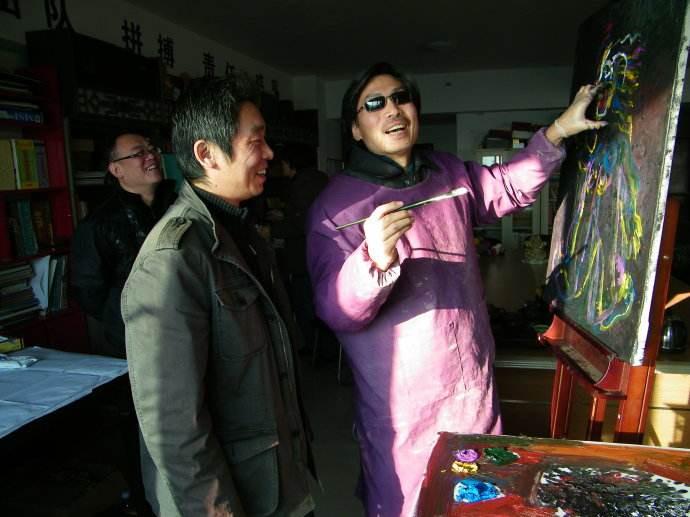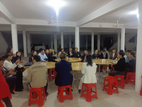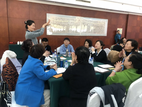Editor's note: Geng Jiayong, born in 1959, lost his sight in 1995 due to too much painting work. Later influenced by his mother, he began to know Christianity and became a Christian. His confidence was restored after his conversion, and he resumed his art work. In recent years, he has produced many ceramics, paintings and calligraphies. He gave himself a stage name "Hei Tian Shuo". "Hei Tian" means the dark environment the blind are in, and the Chinese character "烁" consisting of "huo" (or fire) and "le" (or happy) symbolizing that blind people are happy when they touch God.
The China Christian Daily interviewed him about his conversion story:
China Christain Daily: Could you please first share with us your personal experience? As far as I am concerned, you went blind for drawing paintings for long periods of time. What do you think losing your sight means to you now?
Hei Tian Shuo: The year 1995 was engraved in my mind, it was when I became blind. After losing my sight, I often thought of my childhood unintentionally.
Everyone has his own childhood. I had bright eyes like you do. Childhood seemed so distant while it was so near, leaving me with a lingering aftertaste. I can't help myself from laughing when I recall something interesting. Apart from playing, the happiest thing in my childhood was drawing. I started to draw when I was eight. However, my poor family provided a bad drawing environment when I was young. After school, I often picked up scrap in a dump site and sold junk to make money that was used to support my drawing. After graduating from middle school, I began to work. I had some changes that created a good condition for drawing.
In 1976, I labored in Shiqiao Commune of Zhangdian District, Zibo (a prefecture-level city in central Shandong) , as a response to the Up to the Mountains and Down to the Countryside Movement (a project where about 17 million Chinese urban youth were sent to the countryside to learn from the workers and farmers there). In my spare time, I often helped (production) brigades and teams post slogans and blackboard paper that advocated to obliterate the five black categories (landlords, rich farmers, anti-revolutionaries, bad-influencers, and right-wingers), ox-demons and snake-spirits and the Gang of Four.
In 1978, I was employed by the Zibo Movie Company which was responsible for drawing film advertisements.
I studied in the art department of Shandong University of Arts in 1984 and the oil painting department of China Academy of Art in 1988. It was my real systematic introduction into the Western culture while working in the latter department. I saw many Western art exhibitions there, through which new ideas of my own came to surface.
My painting entitled "The Relic of Nanjing in December 1937" was collected by the Memorial Hall of the Victims in Nanjing Massacre by Japanese Invaders in 1989. During that period, I frequently had blurry vision. Each time when I experienced distorted vision and could not continue my drawing, I would rest on the desk for a while and my eyesight would return to normal. Later, I was examined in a hospital and the doctor diagnosed that I suffered from retinal haemorrhage, vitreous body turbidity and retinal detachment, advising me to temporarily suspend painting and to have a good rest. In that case, I might get better. But the doctor's word just hit my heart, failing to get my attention. Resting in the room, I, unwilling to remain silent, drew a painting for myself as soon as my eyes felt a bit better.


The organizing committee of the Second National College Track and Field Championship requested entries for a logo and emblem in 1993. Winning the first prize, my work was adopted.
Zibo TV station collected its logo from the whole city in May 1994. My logo which was designed with the tool of a magnifying glass was adopted. But unexpectedly, that logo became my last work in my visual drawing art career. I'm unable to appreciate its effect on TV, yet I memorized all the changes of the logo on the screen with a sense in my heart.
Since then, my father took me to hospitals to seek eye treatment, hoping for sight rehabilitation; but, the situation didn't follow the way I wanted to be. Finally, I was transferred to Beijing Tongren Hospital and was informed that there was no hope for me to regain my sight. I was hurt. I couldn't give up hope because my eyes meant a lot to me.
The judgment of the expert from the hospital put an end to my entire painting career. I was completely disappointed and burst into tears. Thinking that my art career would stop here, stop using my paintbrush, and that my efforts could never produce fruits, I had my mind went to a shock and it drew a blank. I had no idea how I left the hospital that day.
In 1995, the brightness was taken away from me. The room I was familiar with suddenly became strange to me and I was like floating in infinite darkness. Unable to take care of myself, I was not used to this dark life. My old mother made three meals a day for me, whose fatigue weighed more heavily on my heart. Helplessness and loneliness occupied me and I was emotionally vulnerable. I cried at the thought of my previous hard work in paintings. I realized that I became a disabled man who could eat without caring for himself. The tears of frustration always cause me to sit up late.
China Christian Daily: When did you start to learn about Christianity? Could you tell me the process?
Hei Tian Shuo: My mother is a Christian, whose conversion has something to do with my eyes. She hoped his son could see and pick up his brush again. She believed in Jesus and shared the good news with me, urging me to convert to Christianity. She said that Jesus could let me receive the sight, but I refused her with disbelief and wanted her not to have faith in that.
As an ordinary retired worker, she didn't know who Jesus was. I told her that he was a foreigner and a religious leader in the West. I added that I knew something about Western art history since my study was about Western painting in the Shandong University of Arts and the oil painting department of China Academy of Art. Most of the Western paintings originated from Bible stories. Since I was fond of Western art and a faithful follower of Western paintings as I observed their color style in paintings, culture and lifestyle, I thought that I knew Jesus well. Considering my disbelief in eastern Buddhism, how could I believe in Jesus who came from the West?
However, my mother had a strong belief that Jesus could give me my eyesight back. She often asked some spiritual grannies to read the Bible and tell the Bible stories to me. Pretending to hear them, I wondered when they would lose confidence (in me). They were so persistent. Listening to the Bible read by those elderly and the stories inside it, I recalled the Western paintings I saw in the past. The Bible stories and the expressions and movements of the figures of each painting popped up to my head again.
I knew Jesus of old in the past, but I studied his life, the painting compositions, his expressions, clothes, the space from a close or a distant view. I also studied the contrast effects of cold or warm colors, rather than welcoming him into my heart at that time. Then suddenly, there was a ray of light in my dark heart, which brought me to the church.
Now I believe that faith in Jesus doesn't come from knowledge; but, from your heart which receives him. It's hard to come before God by your own wisdom and rich knowledge alone.
From the editor: Hei Tian Shuo started to join in church activities since then. He also met his future partner whom God prepared for him in the church.
To be continued...
Translated by Karen Luo












